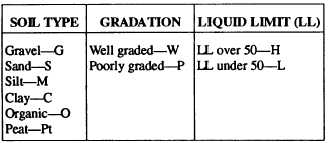SOIL CLASSIFICATION
The principal objective of soil classification is the
prediction of engineering properties and behavior of a
soil based on a few simple laboratory or field tests. The
results of these tests are then used to identify the soil and
put it into a group of soils that have similar engineering
characteristics. Although there are several different
methods of soil classification, the method adopted for
use by the military is the Unified Soil Classification
System (USCS).
Soils seldom exist in nature separately as sand,
gravel, or any other single component. Soils usually
form mixtures with varying proportions of different size
particles. Each component contributes to the
characteristics of the mixture. The USCS is based on the
textural or plasticity-compressibility characteristics that
indicate how a soil will behave as a construction
material.
In the USCS, all soils are divided into three major
divisions: (1) coarse grained, (2) fine grained, and
(3) highly organic. As you know from your previous
studies, coarse-grained and fine-grained soils are
distinguished by the amount of material that is either
retained on or that passes a No. 200 sieve. If 50
percent or more of the soil by weight is retained on a
No. 200 sieve, then the soil is coarse-grained. It is
fine-grained if more than 50 percent passes the No.
200 sieve. Highly organic soils can generally be
identified by visual examination. The major divisions
are further subdivided into soil groups. The USCS
uses 15 groups and each group is distinguished by a
descriptive name and letter symbol, as shown in table
AV-1 of appendix V. The letter symbols are derived
either from the terms descriptive of the soil fractions,
the relative value of the liquid limit (high or low), or
the relative gradation of the soil (well graded or
poorly graded). The letters that are used in
combination to form the 15 soil groups areas follows:
COARSE-GRAINED SOILS
Coarse-grained soils are divided into two major
divisions: gravels and sands. If more than half of the
coarse fraction by weight is retained on a No. 4 sieve,
the soil is a gravel. It is classed as a sand if more than
half of the coarse fraction is smaller than a No. 4 sieve.
In general practice there is no clear-cut boundary
between gravelly and sandy soils, and as far as
behavior is concerned, the exact point of division is
relatively unimportant. Where a mixture occurs, the
primary name is the predominant fraction and the
minor fraction is used as an adjective. For example, a
sandy gravel is a mixture containing more gravel than
sand by weight.
For the purpose of systematizing the discussion, it
is desirable to further divide coarse-grained soils into
three groups on the basis of the amount of fines
(materials passing a No. 200 sieve) they contain.
GW, GP, SW, and SP Groups
Coarse-grained soils with less than 5-percent
nonplastic fines may fall into the groups GW, GP, SW,
or SP. The shape of the grain size distribution curve
determines the second letter of the symbol.
GW AND SW GROUPS.— The GW groups
contain well-graded gravels and gravel-sand mixtures
that contain little or no nonplastic fines. The presence of
the fines must not noticeably change the strength
characteristics of the coarse-grained fraction or interfere
with its free-draining characteristics. The SW groups
contain well-graded sands and gravelly sands with little
or no plastic fines.
GP AND SP GROUPS.— The GP group includes
poorly graded gravels and gravel-sand mixtures
containing little or no nonplastic fines. The SP group
contains poorly graded sands and gravelly sands with
little or no nonplastic fines. These soils will not meet the
gradation requirements established for the GW and SW
groups.
GM, GC, SM, and SC Groups
Coarse-grained soils containing more than
12-percent fines may fall into the groups designated
GM, GC, SM, and SC. The use of the symbols M and C
is based upon the plasticity characteristics of the
material passing the No. 40 sieve. The liquid limit and
16-11

